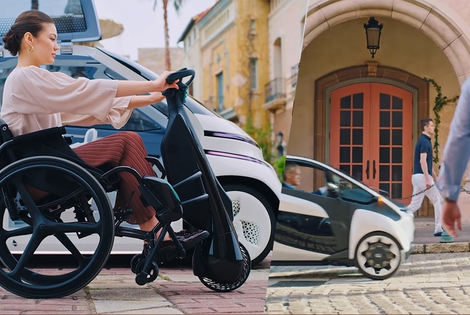
Milan has announced one of Europe’s most ambitious mobility schemes, known as Strade Aperte (open roads). Its goal is to reduce cars in phase 2 of the lockdown by increasing bike lanes and pedestrian areas.
The time has come for cars from the future. Cars talking to the driver, not needing maintenance or even cars using a green fuel get out of screen and get in our garage. Technology has not provided us yet with flying cars or vehicles gliding on roads, defying gravity. Innovation, however, has achieved unexpected goals.
The time has come for cars from the future. Cars talking to the driver, not needing maintenance or even cars using a green fuel get out of screen and get in our garage. Technology has not provided us yet with flying cars or vehicles gliding on roads, defying gravity. Innovation, however, has achieved unexpected goals.
2015 Las Vegas Consumer Electronic Show showcased some cars already on sale, equipped with cutting edge technologies inspired by films, which is an affordable choice for almost everyone, carrying relevant advantages to both buyers and environment. Technology, design and accessories of cars of the future belong to an aware and responsible lifestyle, supported by tests carried out by car producers equipping car with new increasingly eco-friendly accessories.
Alternative fuel. In Back to the Future Part II, Doc looks in the garbage bin for some banana peels and organic waste to allow DeLorean’s time travel to the future, to the far away 2015. 2015, which seemed so distant in 1985, has now come and has carried with it hydrogen-powered cars. Obviously, such cheap and sustainable fuel can’t allow cars to time travel, but it can certainly change the fate of the planet by reducing pollution in the atmosphere.
https://www.youtube.com/watch?v=jfkD3B4MUR4
Voice control. Bluetooth is the technology allowing us to talk with our car. The time has come for Knight Rider and KITT car has come. Cars can already answer text messages while we are driving and enable or disable some features thanks to a simple vocal command. They still don’t have emotions, or autonomous intelligence, but maybe in the near future cars will also present such features.
Autopilot. The automatic pick-up, taking visitors to the Jurassic Park created by Spielberg in 1993, is the film adaptation of the model currently tested at Stanford Artificial Intelligence Laboratory. Designed by Google engineers, the car replaces the driver with an electric control unit which can control, almost like a human operator, all car sensors as well as car connectivity.
https://www.youtube.com/watch?v=-SWUtK3tR5k
No more light bulbs. The luminescent vehicles darting in Tron cybernetic space are the film adaptation of LED technology applied to cars. No more headlight lamps to be replaced or backlit interior. Now LEDs turn on switches, decorate shapes and light up the road with no need at all of maintenance.
Compact and comfortable cars. The extraordinary vicissitudes of the main character feature future cars with clean design, rounded shapes and a spacious and relaxing interior. Today, many cars on sale take notice of this suggestion to design comfortable interiors, not neglecting the slightest detail to make passengers always feel at home.
Siamo anche su WhatsApp. Segui il canale ufficiale LifeGate per restare aggiornata, aggiornato sulle ultime notizie e sulle nostre attività.
![]()
Quest'opera è distribuita con Licenza Creative Commons Attribuzione - Non commerciale - Non opere derivate 4.0 Internazionale.
Milan has announced one of Europe’s most ambitious mobility schemes, known as Strade Aperte (open roads). Its goal is to reduce cars in phase 2 of the lockdown by increasing bike lanes and pedestrian areas.
Formula 1, the world’s most important auto racing championship, has decided to turn the page and aim for carbon neutrality with the support of its teams, drivers and the whole racing circus.
Toyota and LifeGate began telling the story of hybrid mobility back in 2006, now, on the road to the Tokyo 2020 Olympics, they’re still treading the path of sustainable mobility. Here are the main steps of the journey.
Germany’s first solar bicycle lane could be the prototype for the roads of the future. The photovoltaic tiles melt snow and ice, and are capable of absorbing noise.
The Vespa is back in an electric version. Production has just started and the first models can be reserved online starting from October.
The city of Utrecht, in the Netherlands, is home to a bridge for cycling and walking that stretches over roof garden of a Montessori school. This project enhances practicality and will allow families to bring children to school by bike, passing through green areas. Despite their functionality, bridges are often seen as an infrastructure that is
The Lego hair bike helmet is the latest Internet craze. For now it’s just a prototype but production on a large scale will probably start soon.
Just as fires often give way to new growth, after the Dieselgate scandal, which saw Volkswagen cheating on US emission rules, the German car manufacturer radically changed course, beginning to focus on sustainable mobility. The German car company aims to propose thirty zero-emission models and produce at least one million battery electric vehicles by 2025. An ambitious mission
Sustainable, two-wheel mobility is triumphing in Copenhagen. After years of investments, policies, and infrastructural changes, bikes now outnumber cars in the city centre. The website Copenhagenize has released data linked to the number of vehicles entering the city centre, which are monitored by the city’s administration on a daily basis. Last year, 265,700 bikes have entered







